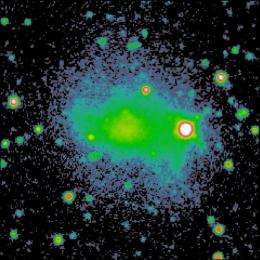Black Holes: Peering Into the Heart of Darkness (w/ Video)

A new infrared image has captured the center of our galaxy in never-before-seen detail--showing stars and gas swirling into the super massive black hole that lurks at the heart of our own Milky Way.
"We can't actually see a black hole because, by definition, no light comes out from it," says University of Florida astronomer Steve Eikenberry. "What we can see, though, is the material around the black hole. As the material spirals into the black hole, it's kind of like water going down the drain in a sink."
With support from the National Science Foundation (NSF), Eikenberry and his colleagues are building and operating a new class of infrared telescope instruments designed to peel back the layers of mystery shrouding black holes.
One of the major questions: How do black holes form? "We are really kind of stumped, and that is one of the great mysteries in astrophysics," he says. "How do you make such a super massive black hole and why are they so common in galaxies? Almost every major galaxy has one."
Eikenberry says the structure of a black hole is not complicated. "A black hole is actually a pretty simple thing when it comes right down to it," he continues. "It's any object that has gravity so strong that not even light can escape from its pull."
But, finer points, such as how black holes interact with their host galaxies, are anything but simple. These are some of the questions Eikenberry is exploring using a new instrument called FLAMINGOS-2 that was built for the Gemini South Telescope in Chile.
FLAMINGOS is short for the Florida Multi-object Infrared Grism Observing Spectrograph. Images and data gathered by it are providing astronomers with some answers about the structure and evolution of a black hole.
"Is it born in the center of this galaxy as a super massive black hole somehow?" Eikenberry wonders. "Or, are they born small and somehow through a merger or through accretion, basically, consuming material around them, do they grow to become big later on?"
Eikenberry also studies smaller, so-called "stellar mass" black holes. A typical galaxy is chock full of them. They are born when a big star dies in a huge explosion called a supernova. He and his team have used FLAMINGOS-2 to study just such stars in the Tarantula Nebula.
"So, we're really sort of understanding not so much the black hole, but the processes that gets you to the point of forming a black hole and how that might influence the formation of these stellar mass black holes," he explains.
Eikenberry says that big or small, black holes likely function much the same. He's hoping to "shed some light" on how they work. It would seem black holes have really sucked him in.
Provided by National Science Foundation





















